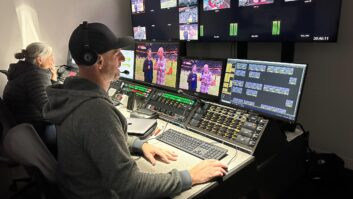Fabio Varolo, sales manager FOR-A Europe, explains how compressed streams such as NDI and SRT are helping to drive the growing rise in remote production.
What industry trends have particularly stood out in 2023?
A very important shift has been the growing rise in remote production. This is seen as a way to reduce production costs and lower the carbon footprint by minimising the number of people and amount of equipment that needs to be shipped to live events for broadcast.

It is really coming into the mainstream because compressed IP links have become much more accepted. While SMPTE ST2110 is still the gold standard for IP connectivity, it is compressed streams like NDI and SRT that are having the impact. NDI, with its bundled facilities for discovery and plug-and-play, is having a great impact because it offers the same simplicity as SDI.
NDI is a proprietary standard, of course, but it is treated as an open format, and manufacturers are actively encouraged to implement it. At FOR-A, for example, we now offer an NDI board for our production switchers, which means they can instantly become part of a network.
What impact are those trends having on the media and entertainment industry?
Remote production over compressed streams has the huge advantage of reducing production costs without materially affecting quality. In turn, that means producers can create more and better content within existing budgets.
One example here is the PTZ camera. Over the same network and connection, NDI-enabled switchers and PTZ cameras can be fully controlled remotely. The larger FOR-A production switchers can store and recall settings for as many as 16 PTZ cameras, which means a single operator at a single panel can handle a very complex production.
Some shows will obviously need full-function, operator-controlled cameras. You are not going to shoot the Champions League Final on PTZ cameras. But this is an amazing flexible and affordable route for all sorts of new content.
How do you see these trends developing in 2024?
In SDI, systems engineers had the freedom to select best-of-breed products from multiple vendors to create the right functionality and workflow. As NDI is adopted by more manufacturers and developers, so it will become as simple to choose the right individual pieces of equipment for a project, confident that the whole network will work out of the box.
Do you see any new trends in 2024?
AI has been talked about a lot, but 2024 will see it introduced in practical solutions. These may not be the applications which are currently talked about: the technology is much more likely to be used to solve complex issues in productivity and operational efficiency.
Complex NDI productions, for example, could use AI to manage the networks, ensuring latencies and synchronisation is controlled when the operation becomes too large for manual control.
AI face tracking could be added to PTZ cameras. Some already offer a degree of automated camera movement, but something more natural and organic would again transform production values and improve quality. Chroma keys could be adjusted using neural processing, automatically generating garbage mattes to minimise the screen size, and fine-tuning the colour selection to maintain a perfect key without impacting the foreground.
All these ideas have the same idea behind them: allowing producers to make better content on smaller budgets, even while technical quality is rising.







